Ask Ethan: Why Doesn’t Every Galaxy Have A Supermassive Black Hole?

And, at some point, did the Milky Way lose ours?
There are some 400 billion objects flying through the Milky Way galaxy with enough mass that — if they were all made of hydrogen and helium atoms — they’d ignite nuclear fusion in their cores and become stars. Most of them actually are stars, but many of them are former stars, existing today as white dwarfs, neutron stars, or black holes. Of the black holes that we have, most of them fall into the category of “stellar mass” black holes, meaning that they arose from stars and have masses that individual stars also possess. But a few black holes grew to be much more massive, and at the center of the Milky Way lies our most massive black hole of all: the 4 million solar mass, supermassive behemoth known as Sagittarius A*. In fact, most galaxies have supermassive black holes, and that’s what Patreon supporter Steve Shaber wrote in to ask about:
“[You’ve said] that most galaxies have a supermassive black hole at the center. I heard the same statement on television this morning. But why would any galaxy not have a supermassive black hole? Do astronomers know for certain that some galaxies lack a black hole at the center — that there’s a hole (so to speak) where the black hole ought to be?”
Oh yes, yes we do know. Here’s the science behind the galaxies without a supermassive black hole at their centers.
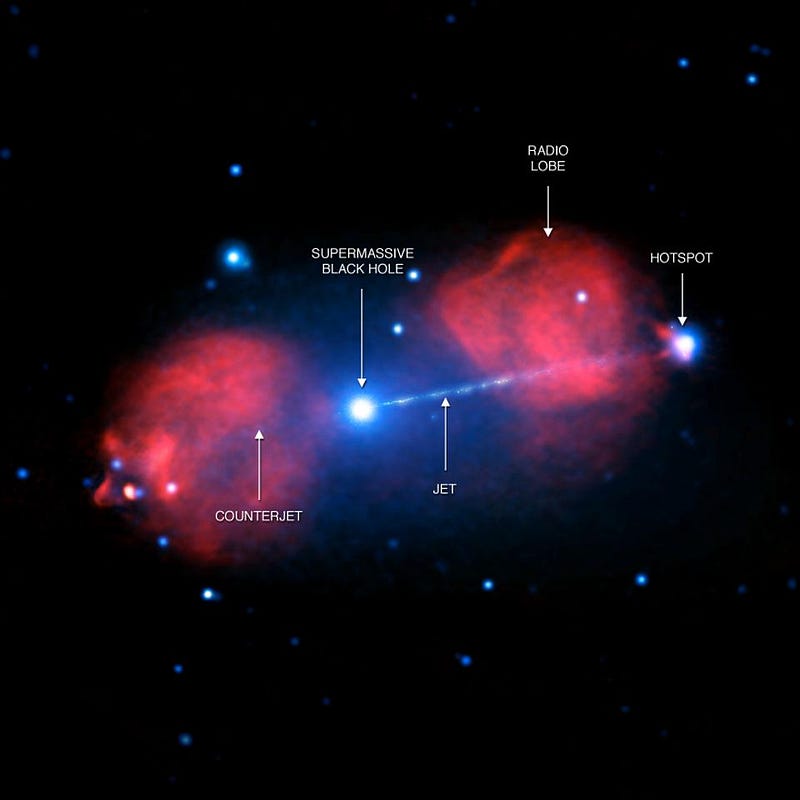
When we look out at the galaxies in the Universe, they come not only in a variety of shapes, sizes, ages, and stellar populations, but also with a wide assortment of activity levels. Some galaxies emit X-rays and radio waves from their centers: a sign of their central black holes actively feeding on matter.
This electromagnetic emission fools many into believing that black holes — objects where gravity is so intense, that nothing, not even light, can escape from its gravitational pull — are somehow a paradox.
That’s not the case at all, though, because this emission doesn’t come from inside the event horizon, but exclusively from outside. The radiation, in fact, comes from matter that’s external to the black hole, from stars, globular clusters, gas, and other objects. When they get close enough to the vicinity of the black hole, the intense tidal forces, which can be quintillions of times stronger than the tides from the Earth-Moon system, rip them apart. That mass then becomes part of an accretion disk (or accretion flow), where it heats up, emits radiation, and much of it eventually falls in, where it grows the black hole in mass.

When we look out at the galaxies we see across cosmic time, many of them appear active. In fact, the image above comes from NASA’s Chandra’s X-ray telescope, and is one of the deepest images of the sky ever taken. More than 7 million seconds — the equivalent of about three months of continuous observation — went into observing this small patch of sky, and practically every point of light appearing in this image corresponds to an active, feeding, supermassive black hole at the center of a galaxy.
These black holes are truly a wonder to observe. We’ve learned, from what we’ve seen, that the Milky Way’s most massive black hole, of ~4 million solar masses, is actually on the small side of things. Most galaxies of comparable sizes that are active have much larger black holes. Andromeda, which is at most about twice the mass of the Milky Way, has a black hole that’s more like ~80–100 million solar masses. Many other galaxies have black holes reaching into the billions or even tens of billions of solar masses.
And, at the limits of our observational capabilities, we find galaxies from when the Universe was only a tiny fraction of its present age, less than a billion years old, that have supermassive black holes that are hundreds, or even close to a thousand, times as massive as our own.
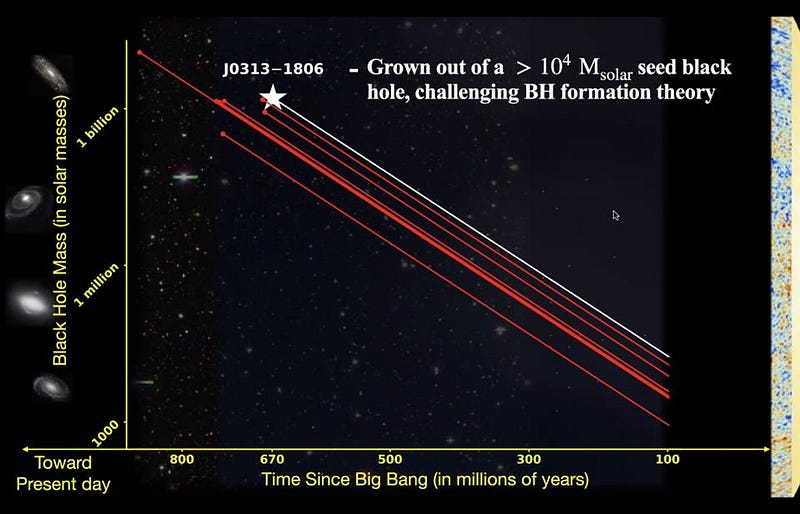
I couldn’t blame you for thinking, based on the evidence of what we do see, that every galaxy in the Universe should have a supermassive black hole at its center. After all, only a fraction of the black holes that exist are supermassive, and only a fraction of the supermassive black holes that exist are active in any way. For example, the galaxy NGC 1277 is close enough and has a massive enough black hole that the Event Horizon Telescope should be able to image it directly, but its inactivity renders it unobservable via this direct method.
Furthermore, the supermassive black hole at the center of our own galaxy is the only one close enough to measure its mass from the motion of individual stars within it. It’s an eminently reasonable thought that every galaxy in the Universe should have a supermassive black hole, especially considering that the processes that we think lead to their formation:
- early, very massive stars form,
- some go supernova and some directly collapse,
- their remnants dynamically interact with the surrounding matter,
- causing them to sink to the proto-galaxy’s center,
- where they merge,
- and then these “seeds” of supermassive black holes accrete matter and grow,
- leading to what we observe today,
ought to occur everywhere a galaxy is present.
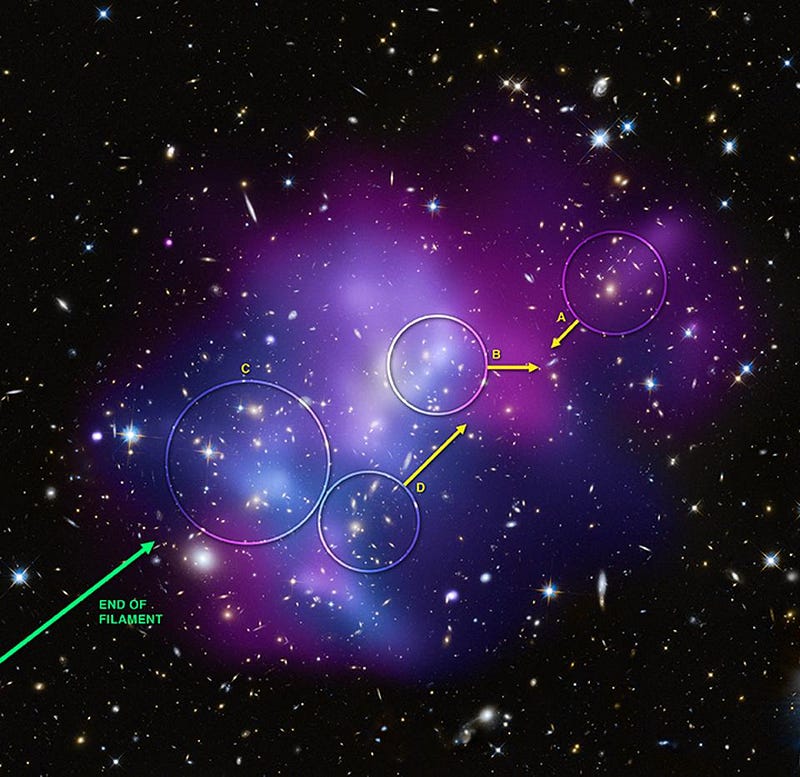
But there’s another part to the story, and that’s what changes everything. Yes, we think that every galaxy — from the process of star-formation and evolution — should spawn the seeds of supermassive black holes, and that given enough time, those seeds should grow into bona fide supermassive black holes. As long as galaxies remain in isolation, it’s very difficult to imagine that something would come along to get rid of these monsters, since, when you work out the equations that govern energy and momentum conservation, you learn that you’d pretty much need something to come along that was more massive than the supermassive black hole if you wanted to gravitationally “kick” it out of the galaxy.
Sure, supernova explosions can kick smaller, stellar mass black holes out of a galaxy; we’ve seen evidence for that occurrence in our own Milky Way relatively recently, in fact. But even the largest, most powerful supernova couldn’t kick a supermassive black hole out of a parent galaxy. There simply isn’t enough energy to get a mass that large moving with enough speed for it to achieve escape velocity.
But there is a way to do it: take another galaxy, one that’s more massive than at least the supermassive black hole you’re asking about, one that very likely also has its own supermassive black hole, and bring it close enough so that you get a gravitational interaction between the two galaxies.
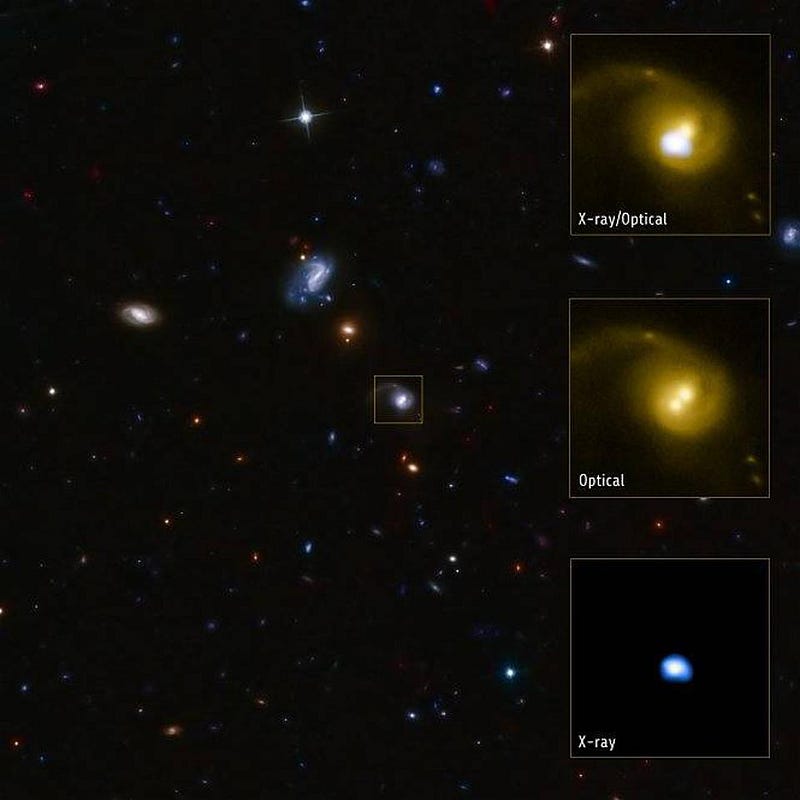
The first observational evidence that such a happenstance could lead to a black hole getting kicked out of a galaxy was uncovered back in 2012, when a supermassive black hole was observed moving out of its host galaxy at a speed of about 5 million kilometers per hour: about 0.5% the speed of light. Above, you can see a picture of two galaxies — with both optical and X-ray data shown — where one of the galaxies is very unusual: it has X-ray emission that’s offset from the center, dominant in one direction, and is moving with a large speed relative to the host galaxy. If you’re interested in learning more, the galaxy is known as CID-42, and is located about 4 billion light-years away.
So what could be causing this?
The best explanation is that there was a recent collision between two galaxies, and that their supermassive black holes collided as well. Because of how gravitational waves work, with an inspiral, merger, and ringdown phase, large amounts of energy can be radiated away. In fact, whenever two black holes merge, about ~10% of the mass of the smaller black hole is converted into gravitational radiation via Einstein’s E = mc². That large energy conversion can sometimes “kick” the post-merger black hole, and in this case, it looks like it kicked it hard enough that it’s being ejected from the galaxy.
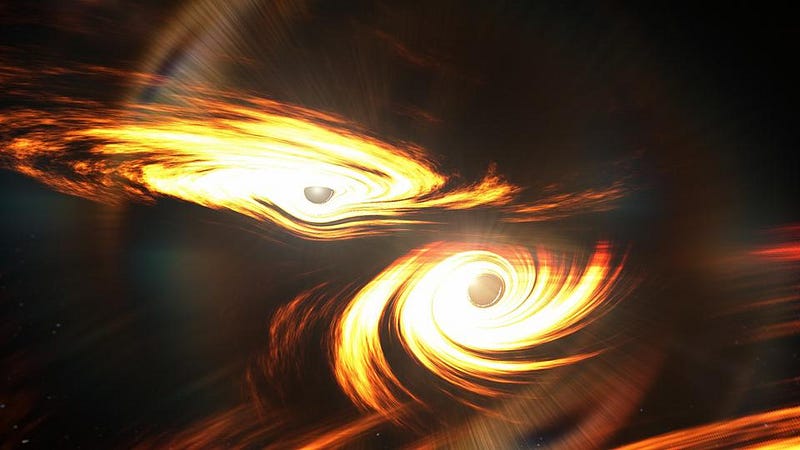
Now, you might worry — if you know quite a bit about energy and momentum — that the supermassive black holes ought to follow their host galaxies, and so if the galaxies merge, you’d expect that the supermassive black holes would remain with those galaxies post-merger as well.
Don’t doubt your intuition; this is what usually happens, most likely. But there are certain parameters that can change the story. Remember the following facts:
- the correlation between galaxy mass and supermassive black hole mass is only a general one, and there are plenty of instances of high-mass galaxies with lower-mass black holes and lower-mass galaxies with higher-mass black holes,
- that when black holes merge, they’ll roughly follow the center-of-momentum frame for the two black holes,
- but that when galaxies merge, they’ll roughly follow the center-of-momentum for the gaseous (and dark matter) components of the host galaxies,
- and that if “fact 2” and “fact 3” give you different momentum vectors, it’s actually very easy for two galaxies to merge and produce a post-merger galaxy where the main pre-existing supermassive black holes have also merged, but are no longer part of that new galaxy.
Indeed, we might have reason to worry if we only ever saw this one example of a galaxy that’s losing a supermassive black hole, or if the data were more ambiguous about what’s happening, such as if another active black hole were part of the CID-42 system. (There isn’t one.)

But it’s definitively not the only example. We discovered a quasar, 3C 186, which we fully suspect is powered by a supermassive black hole, just like all quasars. Only, when we went looking for the host galaxy associated with this quasar, we found that it was moving at ~2000 km/s, or about 0.7% the speed of light, relative to the quasar itself. It takes a huge amount of energy to displace a black hole like this, and quasars are often thought to “activate” in the aftermath of a galaxy merger.
Discovered in 2017, this system appears to exhibit similar properties to CID-42, only this time, the black hole is truly enormous at ~1 billion solar masses. It’s eminently possible that gravitational waves are emitted more strongly in one direction than another, and the post-merger black hole will recoil in the opposite direction. The fact that gravitational waves can carry so much energy is very likely what’s propelling these black holes out of their host galaxies.
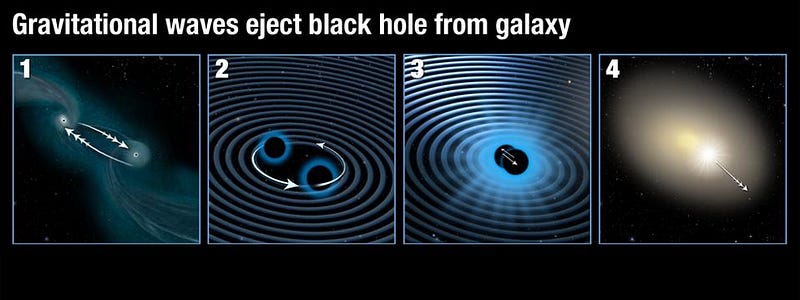
One of the place to look for these black holes in the process of being ejected, as astronomer Yashashree Jadhav noted back in 2019, is for galaxies whose “central” black holes are actually offset from their centers. Indeed, in many such galaxies, it’s noted that those black holes appear to be moving relative to the rest of the galaxy at high speeds: hundreds or even thousands of km/s, or between about 0.1% and 1% the speed of light.
Some of them could be binary supermassive black holes — which we have observed — but somehow where only one member is visible and the other isn’t. (That latter option is something that hasn’t been observed.) It’s possible that other dynamics caused these large black hole velocities, but it’s difficult to think of a mechanism that could impart so much energy to them that wouldn’t also affect the host galaxy similarly. Even the most powerful supernovae, for example, are hundreds of millions of time too weak to cause this effect.
The best story we have today, using only known physics and applying it to the full suite of what we’ve observed, indicates that there ought to be many galaxies out there, even large ones, that lost their supermassive black holes in a recent merger. Although we’ve seen quite a number of these galaxies that look suspiciously devoid of black holes, we have yet to find a supermassive black hole wandering through intergalactic space all by its lonesome.
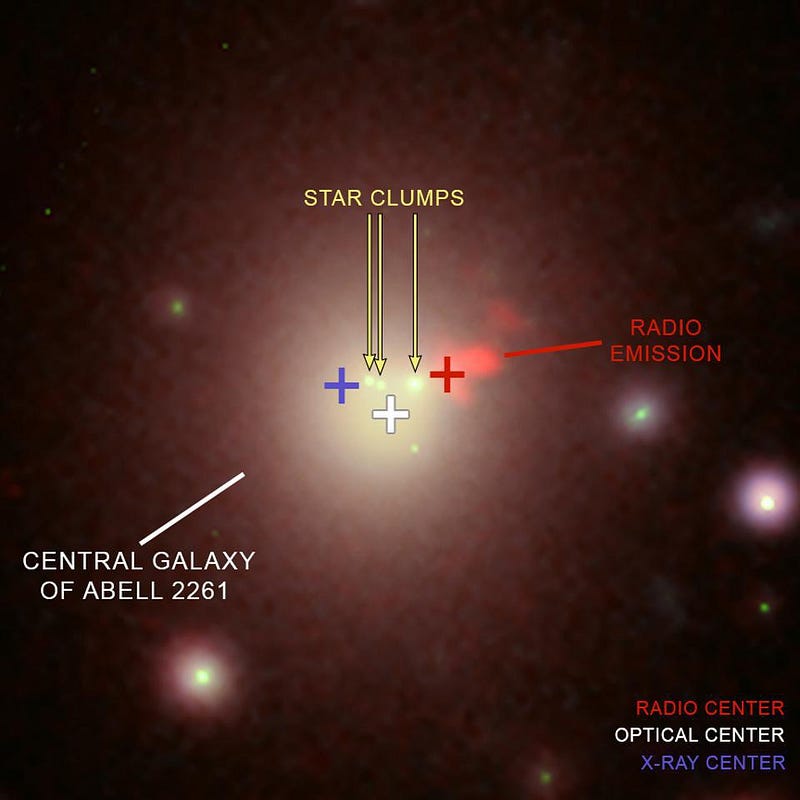
When we put all of this together, it weaves a remarkable tapestry for the story of supermassive black holes. Yes, most galaxies have one, and with every merger, burst of central star formation, or absorption of satellite galaxies, the central black hole will only grow. But occasionally, major (or modest) mergers may lead to supermassive black hole mergers, and they can kick the resultant supermassive black hole out of the host galaxy entirely. We’ve seen some evidence for this, but there are plenty of additional signals and consequences that should arise if this is the case.
There should be many galaxies, particularly in the richest regions of galaxy clusters, that house only very small supermassive black holes, or possibly even none at all.
Galaxies like the Milky Way, with very low-mass supermassive black holes for their sizes, might not be on their first supermassive black holes; we may have lost an earlier, more massive one some time ago.
And we should have supermassive black holes populating intergalactic space, where they might transit in front of background light sources, causing an effect like gravitational microlensing. Unless something is done to mitigate the effects of satellite pollution, however, this last effect might be practically impossible to detect.
Right now, the only mechanism we know of that could separate supermassive black holes from their host galaxies involve a dual merger — of black hole-black hole mergers alongside a galaxy-galaxy merger — where the final momenta of the resulting black holes and galaxies are sufficiently different from one another.
But to learn how common supermassive black hole ejections are, what fraction of galaxies have lost them, and whether there are other mechanisms for black hole ejection (or not), will require further scientific study. Furthermore, learning how (and whether) supermassive black holes regrow is also a tremendous unknown.
However, one thing is certain, whether we like it or not: not every galaxy always has a supermassive black hole, and no matter how much time it’s spent growing one, a merger with the right properties can always take it away. While it might be tempting to make blanket statements that all galaxies have supermassive black holes, the real Universe, as is so often the case, is full of surprising ways to get even the dirtiest of jobs done.
Send in your Ask Ethan questions to startswithabang at gmail dot com!
Starts With A Bang is written by Ethan Siegel, Ph.D., author of Beyond The Galaxy, and Treknology: The Science of Star Trek from Tricorders to Warp Drive.





